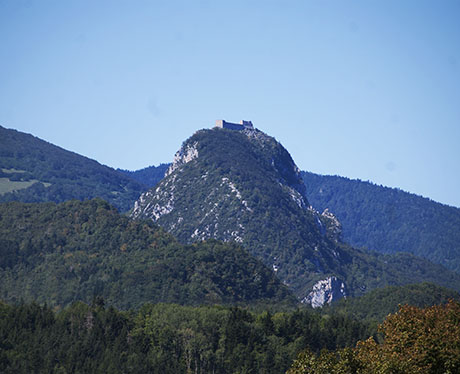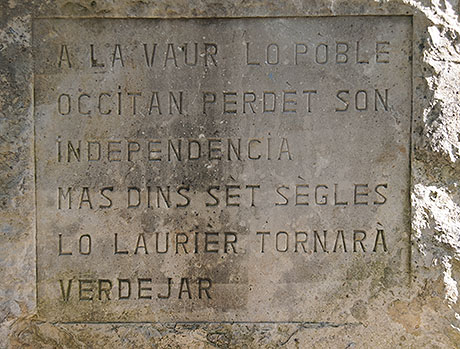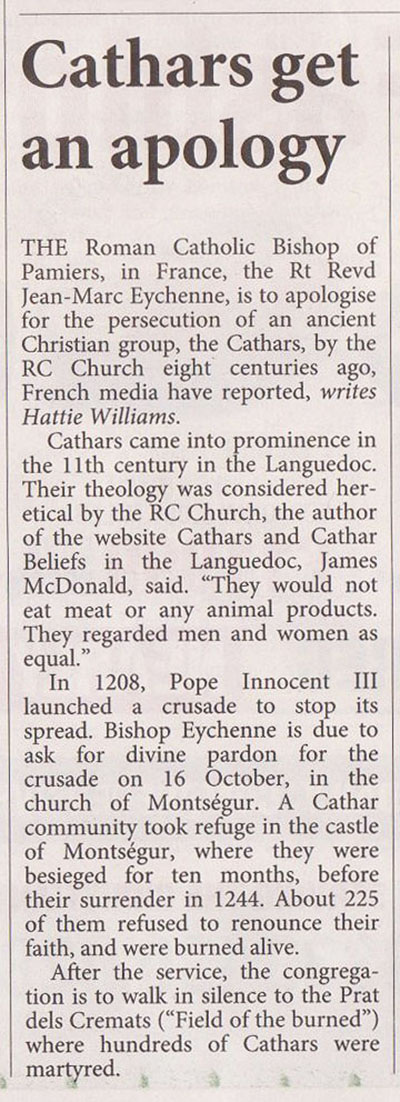Cathars and Cathar Beliefs in the Languedoc
|
|
||||||||||||||||||||||||||||||||||||||||||||||||||||||||||||||||||||||||||||||||||||||||||||||||
|
|
|
|
|
|
|||||||||||||||||||||||||||||||||||||||||||||||||||||||||||||||||||||||||||||||||||||||||||
|
|
||||||||||||||||||||||||||||||||||||||||||||||||||||||||||||||||||||||||||||||||||||||||||||||||
|
|
Cathar News
|
|||||||||||||||||||||||||||||||||||||||||||||||||||||||||||||||||||||||||||||||||||||||||||||||
|
11-12 June , 2020 |
International Society for Heresy Studies -
|
|||||||||||||||||||||||||||||||||||||||||||||||||||||||||||||||||||||||||||||||||||||||||||||||
|
8-11 July, 2019 |
55e Colloque de Fanjeaux - Le "Catharism" en Question.
A conference which, from the speaker list, is evidently dedicated to putting one side of the main contemporay debate within Cathar studies, coincidentally the one favoured by Jean-Louis Biget. Programme: http://cahiersdefanjeaux.com - pdf
|
|||||||||||||||||||||||||||||||||||||||||||||||||||||||||||||||||||||||||||||||||||||||||||||||
| 20 May 2019 |
Death of Professor Bernard Hamilton (27 Sep 1932 - 20 May 2019)
It is with great regret that we record the death of Bernard Hamilton, Professor Emeritus of Crusading History, at the University of Nottingham, one of the most influential medieval historians of the twentieth century, who wrote extensively on the Cathars and Bogomils.
|
|||||||||||||||||||||||||||||||||||||||||||||||||||||||||||||||||||||||||||||||||||||||||||||||
|
9-12 July, 2018 |
54e Colloque de Fanjeaux - L'Eglise et la violence Xe - XIIIe s.
https://cahiersdefanjeaux.com/index.php/806-le-programme-du-54e-colloque-de-fanjeaux-du-9-au-12-juillet-2018 |
|||||||||||||||||||||||||||||||||||||||||||||||||||||||||||||||||||||||||||||||||||||||||||||||
|
2-5 July 2018 |
The International Medieval Congress (IMC) - Leeds
Organised and administered by the Institute for Medieval Studies (IMS). https://www.imc2018.co.uk/ |
|||||||||||||||||||||||||||||||||||||||||||||||||||||||||||||||||||||||||||||||||||||||||||||||
|
15-16 June, 2018 |
Third Conference of the International Society for Heresy Studies - London - Heresy and Borders
http://heresystudies.org/2018-ishs-conference-program/
|
|||||||||||||||||||||||||||||||||||||||||||||||||||||||||||||||||||||||||||||||||||||||||||||||
|
16-17 April, 2018 |
Conference, Oxford University - Forbidden Ideas: Medieval heresy and the scholastics.
TORCH | The Oxford Research Centre in the Humanities Copy of a report by Ann Giletti, Faculty of Theology and Religion Seminar Room, Radcliffe Humanities: 16 - 17 April 2018 Forbidden Ideas gathered experts on medieval heresy for an international, multi-disciplinary conference, which was held in a workshop format. Ten speakers from the UK, continental Europe and the US, ranging from PhD student and postdoc to established expert and professor emeritus, presented at this two-day event. It was organised as part of a Horizon 2020 Marie Curie project (‘Boundaries of Science: Medieval Condemnations of Philosophy as Heresy’). The conference’s approach to the subject of heresy was unusual in two respects. First, its aim was to make a clear distinction between heretical ideas and heretical people, and to look at what made ideas heretical in the Middle Ages. Second, in doing this, it brought together specialists who were diverse not only in their disciplines, but also in their general areas of research: popular heresy (heresies such as Catharism) and academic heresy (heresy in the university context). The paths of these specialists normally do not cross, as the two areas are treated as distinct research topics, and are rarely mentioned together in monographs on medieval heresy. The papers had in common that they examined the work of trained professionals – such as scholastic theologians, bishops and inquisitors – to see how they assessed or labelled ideas as heretical, and the systems in which this took place. Through this combination, the presentations offered diverse and surprising perspectives on how ideas were classed as heretical, and on the formal procedures followed in dealing with them. Five speakers presented on aspects of popular heresy or the institutional systems involved in defining and prosecuting heresy. Irene Bueno (University of Bologna), author of Defining Heresy: Inquisition, Theology, and Papal Policy in the Time of Jacques Fournier (2016), spoke about theological consultations opened by Pope John XXII with scholastic theologians at the Curia, and how the writings of one such theologian, Jacques Fournier, reveals the intellectual processes leading to new codifications of heresy. Lucy Sackville (University of York), author of Heresy and Heretics in the Thirteenth Century: The Textual Representations (2011), and Project Co-Investigator of York’s Doat Project on Inquisition registers of Languedoc, presented on 13th-century heresy trials in Italy, using documents to show how cooperation among bishops, inquisitors and local authorities was necessary for effective pursuit of heretics, and that there was a standard set of offending ideas reported, or looked for, in examining suspects. Amélie de las Heras (IRHT-CNRS, Paris), expert in medieval text and the Iberian Peninsula, assessed the definitions and descriptions of heresies in the works of Martin de León (d. 1203) and Lucas of Tuy (d. 1249), and the heritage of Isidore of Seville in the way they described and denounced heresies. Jack Baigent (University of Nottingham) presented on the coinciding of condemned ideas of two distinct groups, followers of the Waldensians and Spiritual Franciscans in 14th-century Languedoc, and he considered how these groups may have been in contact. Alexander Fidora Riera (Universitat Autònoma de Barcelona), head of the ERC Latin Talmud Project, spoke on how the Latin translation of the Talmud, and the trial and burning of the Talmud in the 1240s, were steps towards reassessing the legal status of Jews and Judaism under Church authority, to class them as heretical. Interspersed with these talks were five by speakers presenting on academic heresy. William Courtenay (Professor Emeritus, University of Wisconsin-Madison), distinguished expert on medieval universities and pioneer researcher into academic heresy, spoke on how Paris university scholastics were caught up in politics of heresy accusations in the clash between Philip IV of France and Pope Boniface VIII, and in Philip’s attack on the Templars, where the scholars were sought after for their expertise. Andrew Larsen (University of Wisconsin-Milwaukee), author of The School of Heretics: Academic Condemnation at the University of Oxford, 1277-1409 (2011), presented on the case of Henry Crumpe (fl. 1380-1401), a figure who participated in carrying out academic censure and yet was also a target of it, and was accused of both academic and popular heresy. Gregory Moule, author of Corporate Jurisdiction, Academic Heresy, and Fraternal Correction at the University of Paris, 1200-1400 (2016), presented on Denis Foullechat, a 14th-century Franciscan and scholastic forced to recant his views on apostolic poverty, whose case is revealing about contemporary understanding of heresy as a criminal offence. Deborah Grice (University of Oxford), expert on the University of Paris Condemnations of 1241, analysed use of the terms ‘error’ and ‘heresy’ by Albertus Magnus to speak of dangerous ideas. Ann Giletti (University of Oxford) spoke on how scholastics labelled dangerous philosophical theories as heretical, and on medieval authority to declare ideas heretical. A round table at the end of the proceedings was chaired by Kantik Ghosh (University of Oxford), author of The Wycliffite Heresy: Authority and the Interpretation of Texts (2002). Throughout the conference, discussion drew together ideas from the various papers; and the round table took up the themes of diverse approaches of historians of popular and academic heresies, as well as questions that arise in distinguishing between heretical people and heretical ideas. The workshop format worked well in fostering a stimulating and productive environment. One-hour slots for presentations gave time for case studies and in-depth analysis, as well as open discussion. Fruitful exchanges took place among the speakers and participants in the event. Several participants commented that they enjoyed and learned from the presentations, and that they were pleased to make contact with the speakers. The venue, the Seminar Room in the Radcliffe Humanities building, provided a comfortable setting with excellent handicap access. OMS and TORCH kindly gave us the venue free of charge, with OMS generously awarding a grant for catering costs, and TORCH supplying invaluable help in managing logistics during the event. Marie Curie funding covered the travel and accommodation costs of the speakers. We are very grateful for all of this support, and the opportunity for dialogue it fostered. This conference was organised as part of a Horizon 2020 Marie Curie project https://www.torch.ox.ac.uk/forbidden-ideas-medieval-heresy-and-scholastics
|
|||||||||||||||||||||||||||||||||||||||||||||||||||||||||||||||||||||||||||||||||||||||||||||||
|
11-12 April, 2018 |
Conference on Heretical Self-Defence, University of Nottingham, UK.
https://www.nottingham.ac.uk/conference/fac-arts/humanities/history/heretical-self-defence/heretical-self-defence.aspx |
|||||||||||||||||||||||||||||||||||||||||||||||||||||||||||||||||||||||||||||||||||||||||||||||
|
19 juillet, 2017 |
Conférence: Château de Pieusse, près de Limoux. Mercredi 19 juillet. 18 h 30. Entrée libre et gratuite.A la frontière de l’Histoire et du mythe. La recherche des trésors cachés en pays d’Aude (1800-1966), par Charles Peytavie, historien médiéviste, spécialiste du catharisme. Fondateur du Cabinet d’ingénierie culturelle et touristique Patrimoines d’Avenir. Président de la Société d’Etudes Scientifiques de l’Aude, administrateur de l'AEC/ Nelli. |
|||||||||||||||||||||||||||||||||||||||||||||||||||||||||||||||||||||||||||||||||||||||||||||||
|
6 July, 2017 |
International Medieval Congress - Leeds - Heresy
|
|||||||||||||||||||||||||||||||||||||||||||||||||||||||||||||||||||||||||||||||||||||||||||||||
|
3-6 July, 2017 |
53e colloque de Fanjeaux, du 3 au 6 juillet 2017(Corps saints et reliques dans le Midi sous la présidence de Catherine Vincent (Université Paris Ouest Nanterre) |
|||||||||||||||||||||||||||||||||||||||||||||||||||||||||||||||||||||||||||||||||||||||||||||||
|
18 January, 2017 |
Conference in London on the book Cathars In Question.5:30-8.00 pm. UCL. IAS Common Ground, Ground Floor, South Wing, Wilkins Building. |
|||||||||||||||||||||||||||||||||||||||||||||||||||||||||||||||||||||||||||||||||||||||||||||||
|
19 November 2016. |
Colloque à Toulouse intitulé « Convivéncia, un nouvel art de vivre ensemble » |
|||||||||||||||||||||||||||||||||||||||||||||||||||||||||||||||||||||||||||||||||||||||||||||||
| 16 October 2016. |
Apology
by the Bishop of Pamiers for the persecution of the Cathars of the
Languedoc
|
|||||||||||||||||||||||||||||||||||||||||||||||||||||||||||||||||||||||||||||||||||||||||||||||
|
|
Apology by the Bishop of Pamiers
On October 16, 2016, the Roman Catholic Bishop of Pamiers apologised for acts contrary to Gospel. Though not explicit, these acts are widely taken to include the Crusade against the Cathars, the activities of the Inquisition in the Languedoc, and in particular, the burning of some 225 baptised Cathars at Montsegur in 1244. Speaking in French, the bishop said:
The Bishop's apology was made specifically on behalf of his diocese. The apology was made at a crowded hour-long service (a "celebration" not a mass) at the village Church of Montsegur - with a thousand or so listening outside. The Cathars' distinctive form of the Lord's prayer was sung in the church. Cathars never built or used church buildings, so this might have been the first time the Cathar form of the Lord's Prayer has ever been used in a church. Red and gold flowers - the colours of both the Counts of Foix and the Counts of Toulouse decorated the church. Outside many carried flags bearing the red and gold cross of Toulouse, the heraldic device of the Counts of Toulouse eight hundred years ago. The general perception was that this ceremony was perfectly pitched. Even the weather cooperated providing an almost cloudless October sky. The ceremony was conducted in a mixture of Occitan and French. Monseigneur Jean-Marc Eychenne looked perfectly at ease and smiled warmly throughout the songs sung in Occitan. In his address, he referred specifically to Cathars as brothers and sisters - an acknowledgment of their Christian faith. He also referred by name to Bertrand Marty, a Cathar bishop who was burned at the stake at Montsegur in 1244, and he explicitly used the word "persecution". Nòstre Paire, The Lord's Prayer was read in Occitan by Muriel Batbie-Castell, then recited by the congregation in French (For Cathars, the Lord's Prayer held special significance retained from the earliest days of Christianity). She also sang « Ihesus Cristz » written in 1275 by Guiraut Riquier one of the last troubadours, who had had personally experienced the crusade and the inquisition, before he went into exile in Aragon. The group Terra Maïre sang a moving "Cathar anthem" Lo Boièr in Occitan. At the end the bishop participated actively in the Pax - a practical realisation of the theme of reconciliation. After the celebration those present, including the bishop, Monseigneur Jean-Marc Eychenne, then walked in silence to a nearby field, to a place thought to mark the spot where some 225 baptised Cathars were burned alive in 1244. Everyone carried branches of laurel - a reference to an Occitan saying associated with the Cathars, and predicting the revival of Occitan culture after seven hundred years (The last known baptised Cathar in the Languedoc was burned alive by the Archbishop of Narbonne in 1321, so the seven hundredth anniversary will fall in 2021). Music, Graile e de la Bodèga was played by Xavier Vidal et Claude Roméro. Se Canto, the Occitan national anthem was sung. Claude Marti sang "Montségur". Along with his sprig of laurel, the bishop carried a simple shepherd's crook made of wood and iron, another gesture of humility that resonated well - Monstsegur like much of the diocese lies in mountainous sheep country, and many Cathar shepherds would have carried similar crooks in the High Middle Ages. Formalities concluded with a "verre de l'amitié" at the village hall.
The clear consensus among those present was that this apology marked an important historical event. The bishop was born in Pamiers, so understood local sensibilities. He and his clergy recognised that the wound inflicted in the thirteenth century was still raw and bleeding in the twenty-first, that the embers were still glowing. He has done pretty much everything that could be expected of him. Those present, from supposed neo-Cathars to government functionaries, from academics to Catholic clergy appeared happy with the day's events. Many were visibly moved. A great a success as it was, the bishop's apology is widely seen as only the start. As Bertrand de la Farge put it, "Today's event is the first step of a process". Medieval Bishops of Pamiers played a small and late (though well publicised) part in the persecution of the Cathars. Those who share a much greater portion of responsibility for the persecution of the Cathars include the whole of the Catholic Church as a corporate entity, the papacy, the Cistercians, the Dominicans and the archbishoprics of Narbonne and Toulouse. Cistercians promoted a Crusade against the Cathars of the Languedoc, and the head of the Cistercian Order, the Abbot of Cîteaux, personally commanded the Crusade during its initial phase. Dominicans created and manned the first papal Inquisition, the organisation tasked with the extirpation of the Cathars after the Crusade. The bald fact is that along with local bishops they were responsible for burning alive countless thousands for the crime of disagreeing with them - not for anything else. That eight-hundred year old wound is unlikely to heal until they each make unconditional apologies with the same grace as Monseigneur the Bishop of Pamiers. Representatives of the Cistercian and Dominican Orders had been invited on the 16th October, but were not present at the ceremony.
Media Coverage
International
BBC, World Service Global News 17 October 2016. Full Programme (relevant news item at 23 mins 22 secs) Just the relevant news item (very good piece by Hugh Schofield)
BBC, Radio4 The World Tonight 17 October 2016 - Audio in English Full Programme (link to BBC) (relevant news item at 41 mins 39 secs) Just the relevant news item (populist piece by Shaun Ley, mainly from an ill-informed novelist who happens to be a previous Chairman of the BBC)
Church Times, Cathars Get An Apology, 7th October 2016 . Radio
Vatican: L'évêque de Pamiers : pardon pour les
crimes contre les cathares, 17 October 2016.
French Media
Le Figaro: L'Eglise demande pardon pour les Cathares, 16 October 2016 France Inter :le-journal-de-19h-23-septembre-2016, AFP (reportage vidéo): Montségur: L'église demande pardon aux Cathares, 17 October 2016 Le Point: L'Église d'Ariège demande pardon pour le massacre des cathares, 22 Septeber, 2016 France-3. L’église catholique d’Ariège demande pardon pour Montségur, 20 September 2016 France-3. La repentance de Montségur, 12 October 2016 France-3. Le laurier a bien reverdi à Montségur, 16 October 2016 La Dépêche: L'Eglise demande pardon pour le massacre des cathares, 23 September, 2016. La Dépêche: Dimanche, l'Église d'Ariège demandera pardon aux Cathares, 15 October 2016 La Dépêche: Cathares : l'église demande pardon, 17 October 2016 La Croix: L’évêque de Pamiers demande pardon pour le sort réservé aux cathares, 16 October 2016 La Croix: Comprendre l’hérésie cathare, 8 October 2016 La Gazette Ariégeoise: Catharisme et Paratge : pourquoi nous étions à Montségur, 17 October 2016 Ariege Catholique, DRAME DE MONTSÉGUR : L’Église d’Ariège a fait sa démarche de pardon, 17 October 2016. Includes, verbatim, the Communiqué and Homélie of Monseigneur Jean-Marc Eychenne at Montségur, in French. Famille Chretienne, 17 October 2016
Occitan Media
La Setmana: Perdon de Montsegur «nos cal avançar, sens oblidar», 17 October 2016
France-3. 19/20 Journal occitan et catalan, video report, 22 October 2016
Press Releases
|
|||||||||||||||||||||||||||||||||||||||||||||||||||||||||||||||||||||||||||||||||||||||||||||||
1. In the Church at Montsegur. |
2. In the Church at Montsegur. |
3. In the Church at Montsegur. |
4. In the Church - Bishop speaking. |
5. In the Church - The Pater Noster in Occitan |
6. In the Church - Terre Maire |
7. Outside the Church - Bells |
8. The "Cathar anthem" Lo Boièr played on Occitan bagpipes below the Pog of Montsegur |
9. Se Canto below the Pog of Montsegur |
|
The castle, pog and modern village of Montsegur. |
 |
|
The village church at Montsegur before the celebration on 16 October 2016. |
 |
Invitees
Diocèse
Mgr Jean-Marc Eychenne
Abbé Gilles Rieux
Abbé Serge Billot
Abbé Jean Kadende
Abbé Pierre Bousquier
Abbé Edouard de Laportalière
Abbé Antoine Reneaut
M. et Mme Michel Carayol
Mme Fabienne Eychenne (diocèse)
M. Théophile Bolon (diocèse)
Abbé Jordy Passerat (Occitanie)
Abbé Jean-Claude Vasseur (Toulouse)
Orthodox Church
M. Pascal Scordino et famille
Functionaires
M. Christophe Hériard (Préfecture)
Mme Anne Peny (Préfecture)
M. Gérard Onesta (Région)
M. Patrick Roux (Région)
M. Kamel Chibli (Région)
M. Marc Sanchez (Pays d’Olmes)
M. Gérald Sgobbo (Pays d’Olmes)
M. Stéphane Bourdoncle (Pays d’Olmes)
M. Barthélémy Maris (Pays d’Olmes)
M. Robert Finance (Mayor of Montségur)
M. Jean-Michel Lattes (Toulouse)
M. le colonel Wanecque (Gendarmerie)
Convergence Occitane
M. et Mme Bertran de la Farge
M. et Mme Jean-François Laffont
M. et Madame Patrick Lasseube
M. Jean Villeroux
M. James et Mme Sophie McDonald
Dr. Yuri Stoyanov
Artistes, Performers
Mme Muriel Batbie-Castell (artiste)
Mme Béatritz Lalanne (artiste, Terra Maïre)
Mme Marie-Ange Gacherieu (artiste, Terra Maïre)
M. Thierry Marcoux (artiste)
M. Claude Roméro (artiste)
M. Xavier Vidal (artiste)
Mme Alix Dubault (intervenante)
Mme Inge De Robert (intervenante)
Société M2 Music : M. Jacques Ghilardi et M. Fabien
Gadmer (logistique : sono)
Mme Marie-Françoise Pujol (logistique)
M. Claude Marti (artiste)
M. Serge Pey (artiste)
M. Francis Fourcou (réalisateur) et son équipe.
M. Gérard Jazottes (Toulouse)
Press / Media
|
|
|
The crowded parvis at the village of Montsegur on 16 October 2016. |
|
Monseigneur Jean-Marc Eychenne, |
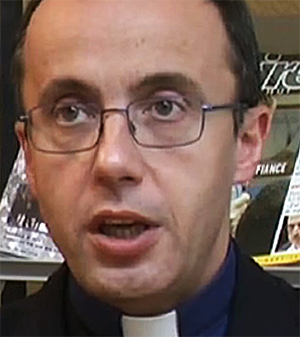 |
|
The celebration inside the village Church of Montsegur |
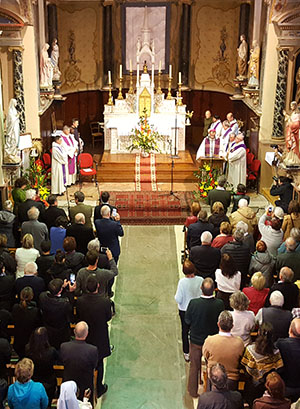 |
|
Monseigneur Jean-Marc Eychenne, Bishop of Pamiers |
|
National media in the gallery of the church. |
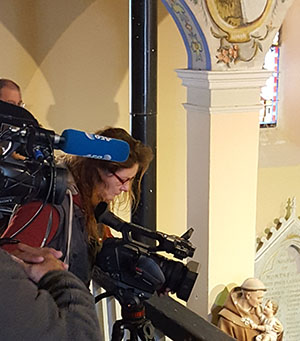 |
|
Asking God for pardon |
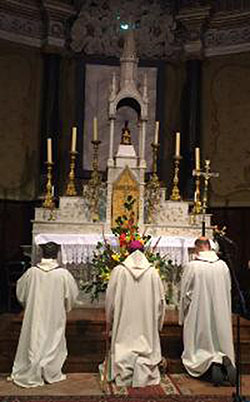 |
|
Terra Maïre |
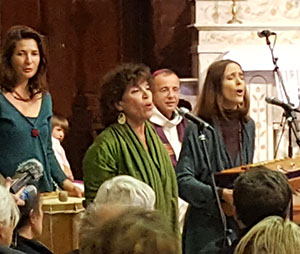 |
|
Monseigneur Jean-Marc Eychenne, Bishop of Pamiers in front of Montsegur |
.jpg) |
|
Monseigneur Jean-Marc Eychenne, Bishop of Pamiers carrying a laurel branch. |
|
The flag of the Counts of Toulouse |
|
The crowd carrying laurel branches at the village of Montsegur on 16 October 2016. |
|
Monseigneur Jean-Marc Eychenne, Bishop of Pamiers with M. Pascal Scordino representing the Orthodox Church |
|
Occitan music. |
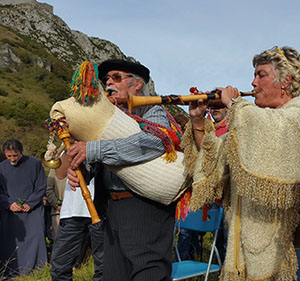 |
|
Singing an Occitan anthem |
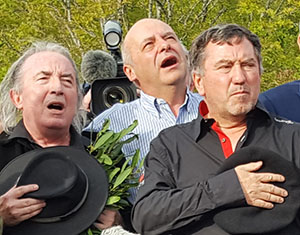 |
|
A Laurel Branch |
|
Chevaliers et gentes dames d'Occitanie. The cross of Toulouse is popular among re-enactors - who often supplement it with gold fleurs-de-lys, for reasons that are difficult to imagine. |
|
Singing Se Canso |
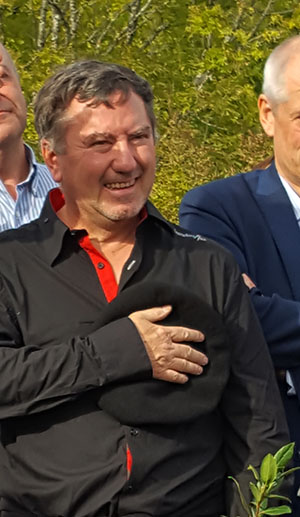 |
|
Monseigneur Jean-Marc Eychenne, Bishop of Pamiers |
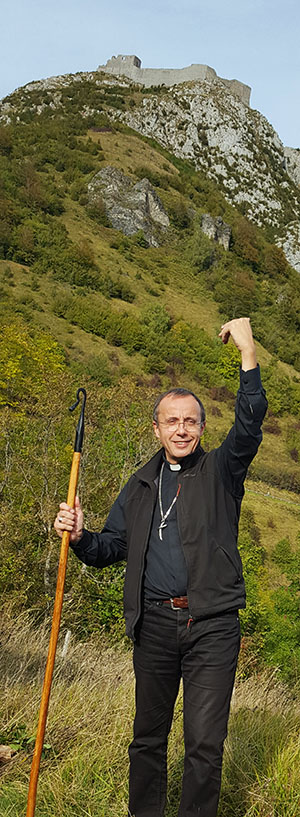 |
|
Occitan Musician |
|
A representative of the academic community |
|
Monseigneur Jean-Marc Eychenne, Bishop of Pamiers |
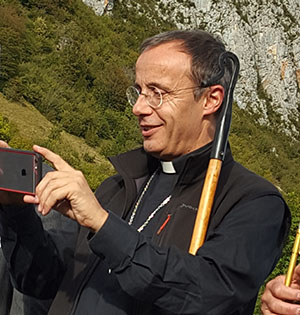 |
|
|
|
The memorial stele at the Pat des Cremats at moonrise on 16 October 2016 (Photo courtesy of Richard Stanley) |
Photographs
|
The Bishop and his clergy in the Church of Montsegur on 16 October 2016. |
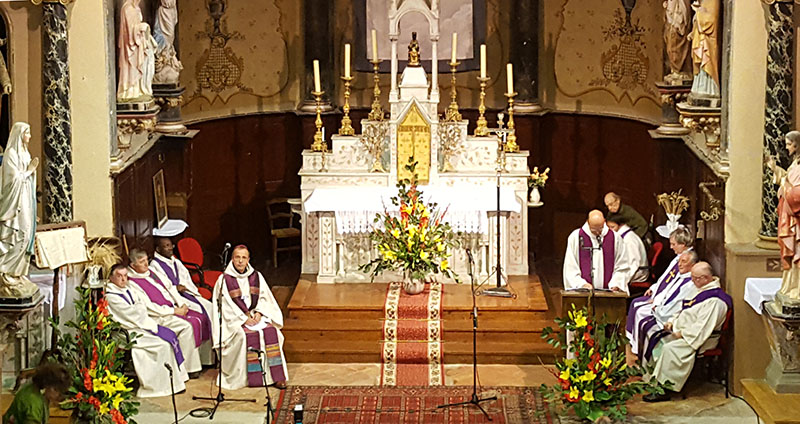 |
|
Lord's prayer being recited in Occitan by Muriel Batbie-Castell in the Church of Montsegur |
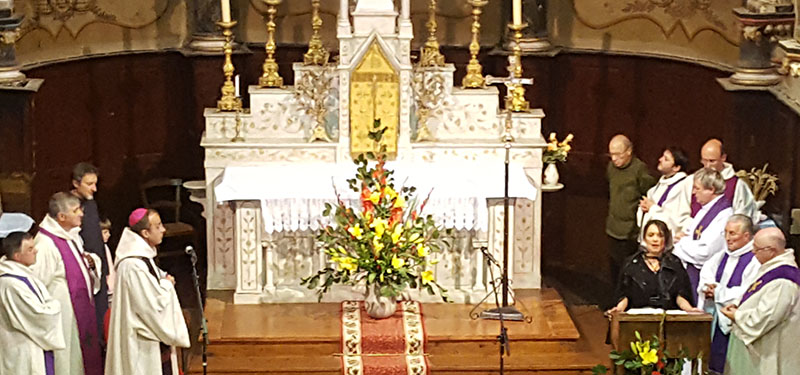 |
| Monseigneur Jean-Marc Eychenne, Bishop of Pamiers carrying a laurel branch. |
|
Monseigneur Jean-Marc Eychenne, Bishop of Pamiers carrying a laurel branch. |
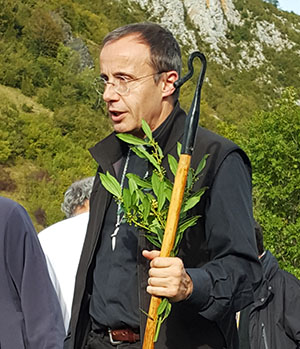 |
|
Monseigneur Jean-Marc Eychenne, Bishop of Pamiers |
|
Monseigneur Jean-Marc Eychenne, Bishop of Pamiers |
 |
|
Monseigneur Jean-Marc Eychenne, Bishop of Pamiers with Abbé Edouard de Laportalière |
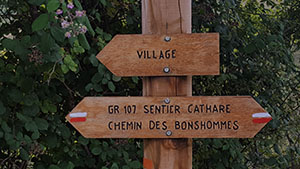 |
| The memorial stele at the Pat des Cremats at moonrise on 16 October 2016 (Photo courtesy of Richard Stanley) |
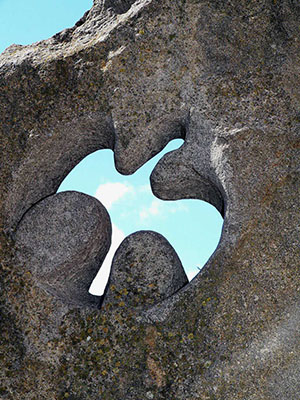 |
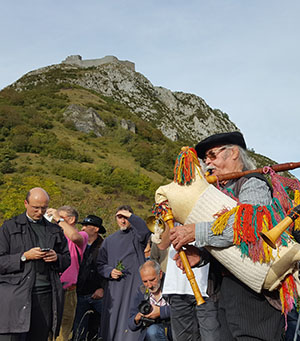 |
|
Monseigneur Jean-Marc Eychenne, Bishop of Pamiers |
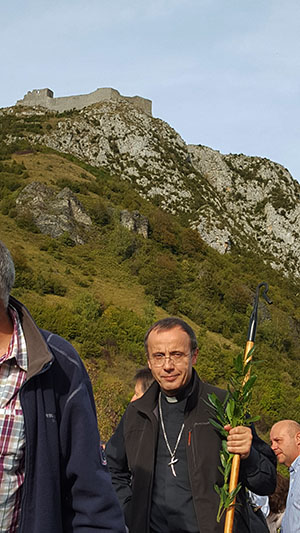 |
|
The crowded parvis at the village of Montsegur on 16 October 2016. |
| Abbé Edouard de Laportalière |
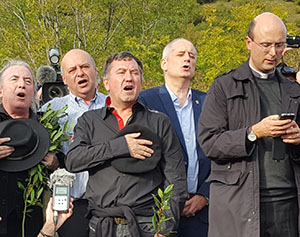 |
|
Monseigneur Jean-Marc Eychenne, Bishop of Pamiers |
|
Monseigneur Jean-Marc Eychenne, Bishop of Pamiers |
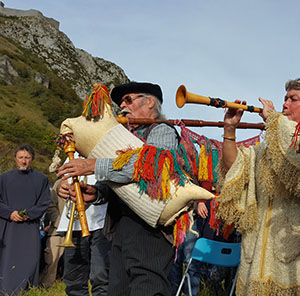 |
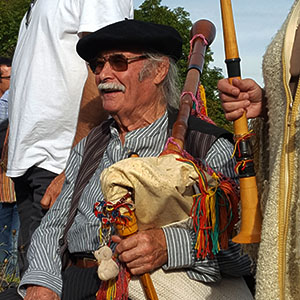 |
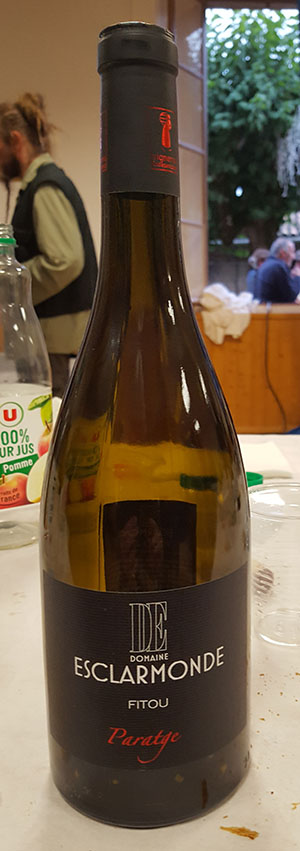 |
|
Terra Maïre |
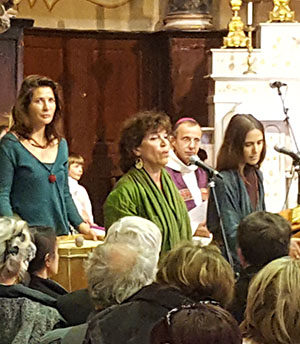 |
|
Monseigneur Jean-MarcEychenne, Bishop of Pamiers |
|
Monseigneur Jean-Marc Eychenne, Bishop of Pamiers |
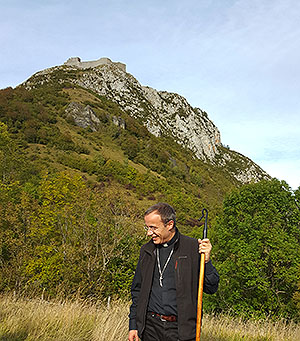 |
|
Terra Maïre |
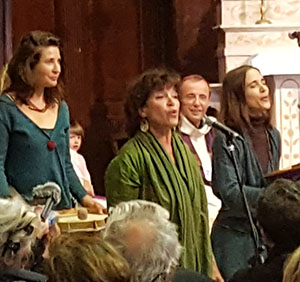 |
|
Monseigneur Jean-Marc Eychenne, Bishop of Pamiers |
|
Monseigneur Jean-Marc Eychenne, Bishop of Pamiers |
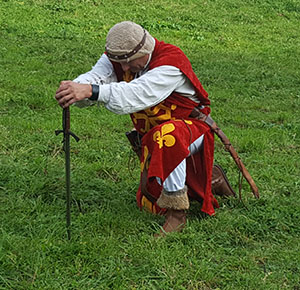 |
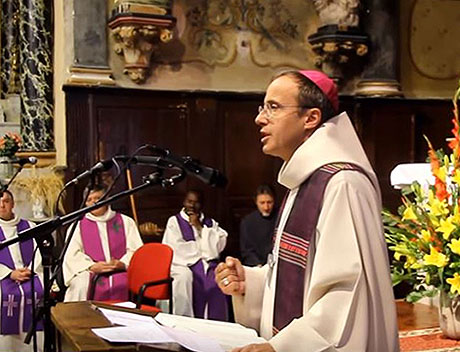 |
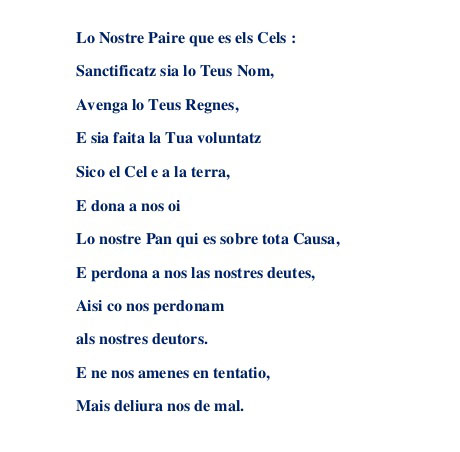 |
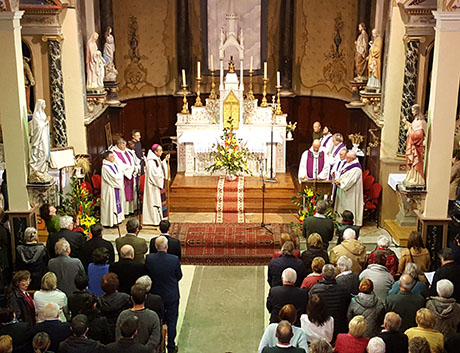 |
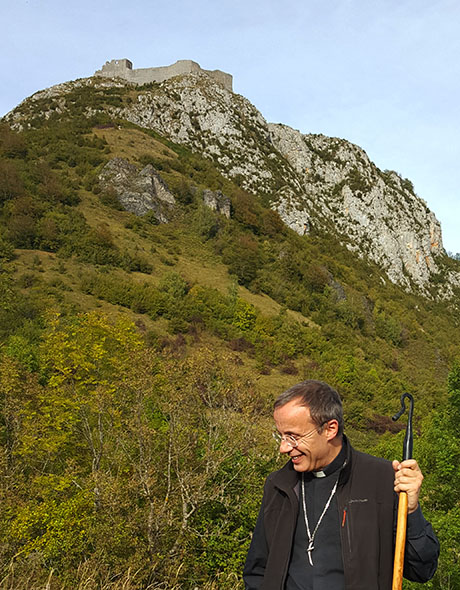 |
|
Montsegur, |
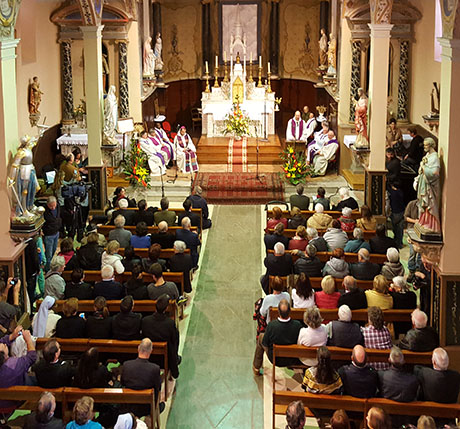 |
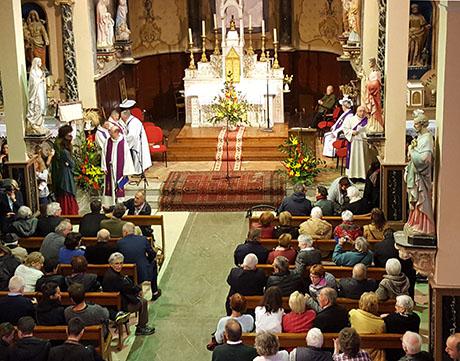 |
|
Terra Maïre Singing Lo Boièr in Occitan |
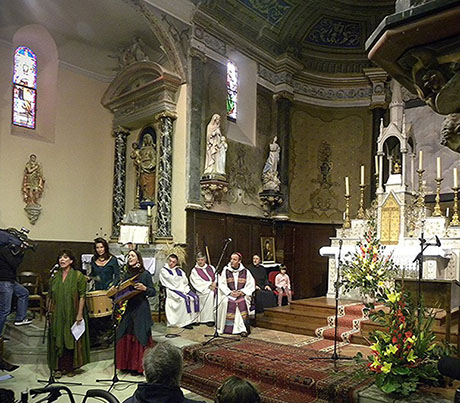 |
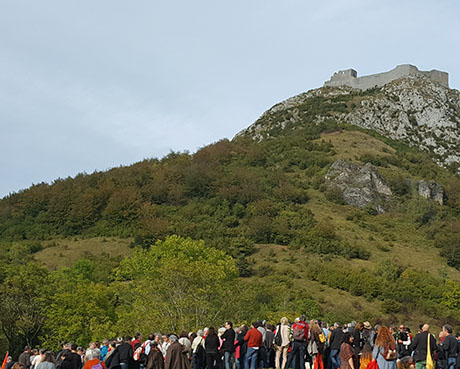 |
 |
Apology - Press Releases
Press Release - Cathar Info - 16 October
Contact:
Sophie Duncan
sophie@cathar.info
French Catholic Bishop asks forgiveness for the Treatment of the
medieval Cathars.
October 16, 2016.
The Roman Catholic Bishop of Pamiers today apologised for acts contrary to Gospel. These acts included the Crusade against the Cathars and specifically the burning of some 225 baptised Cathars at Montsegur in 1244. Speaking in French, the bishop said:
"We ask the Lord for forgiveness for some of our members and some of our institutions participating in acts contrary to the Gospel, in which the Lord Jesus gave us the commandment to love our neighbour and not to respond to violence with violence"
The Bishop's apology is specifically on behalf of his diocese, not on behalf of the whole Church, nor of the Papacy. James McDonald, an historian specialising in the fate of the Cathars, pointed out that the institutions referred to might be the Cistercians and Dominicans. Cistercians promoted a Crusade against the Cathars of the Languedoc, and the head of the Cistercian Order, the abbot of Cîteaux, personally commanded the Crusade during its initial phase. Dominicans created and manned the first papal Inquisition, the organisation tasked with the extirpation of the Cathars after the Crusade.
Representatives of the Cistercian and Dominican Orders had been invited, but were not present at the ceremony.
The apology was made at a crowded service (a "celebration" not a mass) at the village Church of Montsegur - with a thousand or so listening outside The Cathars' distinctive form of the Lord's prayer was sung in the church. Those present, including the bishop, Monseigneur Jean-Marc Eychenne, then walked in silence to a nearby field, to a place thought to mark the spot where some 225 baptised Cathars were burned alive in 1244. They carried laurel branches - a reference to an Occitan saying associated with the Cathars. The bishop carried a simple shepherds crook along with his sprig of laurel.
James McDonald noted that the Cathars never built or used church buildings, so this was probably the first and only time the Cathar form of the Lord's Prayer had ever been used in a church.
Background
The Cathars were a Christian group who flourished in the Languedoc - not then part of France but now the French région of Occitanie. Cathar theology was different from that of the Orthodox and Roman Catholic Churches, and represented the survival of an early strand of Gnostic Christianity. Cathars were so popular among all classes of society that the Catholic Church foresaw the danger of the whole of Western Christendom adopting the Cathar faith. In 1208, after a failed programme of preaching and public debates, Pope Innocent III authorised a formal crusade against the Cathars of the Languedoc and against the local nobility for failing to eradicate them. The crusade, known as the Albigensian Crusade, was led by an abbot, the head of the Cistercian Order, the same man who had led the earlier failed preaching campaign. In a letter to Innocent III reporting his first military engagement in 1209 he described the slaughter of the entire population of the city of Béziers by the papal army, claiming that "our men" had killed 20,000 "without regard to rank, age, or sex".
The Crusade proved successful but, even after twenty years of war, pockets of Catharism survived in secret. The Dominicans, a monastic order created by Dominic Guzman (now Saint Dominic) to assist in the preaching campaign, having failed in their first objective, now found themselves a new role. They created the Inquisition, an organisation that would be formally authorized by the pope in 1233. This was the first papal inquisition, forerunner and model for the Spanish Inquisition two centuries later. It pioneered the methods of psychological manipulation, torture and burning supposed "heretics" alive. It succeeded in extirpating Catharism in the Languedoc.
Both Montsegur and Pamiers are significant locations. The most famous Cathar refuge was the castle of Montsegur which held out long after the end of the initial crusade. A garrison of some 200 Cathar sympathisers protected a similar number of baptised Cathars. The garrison withstood a siege of 10 months by a Catholic army reportedly 10,000 strong. On the surrender, around 225 baptised Cathars were found in the castle. 25 or so had been baptized just days earlier, in full knowledge of the consequences. Offered their lives, not one of the 225 could be induced to recant. All were marched into a purpose built wooden pen filled with firewood on the morning of 16 March 1244 and burned alive. They included three generations of one family: grandmother, mother and daughter.
A re-emergence of Catharism occurred in the early fourteenth century in the nearby bishopric of Pamiers. Jacques Fournier then Bishop of Pamiers created his own episcopal inquisition in conjunction with the Dominican Inquisition based in Carcassonne. He conducted interrogations in person, and kept a personal copy of depositions, taking this copy with him when he moved on within the Church hierarchy. He was later elected pope. As Pope Benedict XII his personal records ended up in the Vatican archives, where they would be rediscovered by French historians in the 1960's, providing material for a well-known micro-history Montaillou. This book was named after a village where the whole population had been arrested by the Inquisition.
Sophie Duncan
Cathar Info,
Chateau St Ferriol,
St-Ferriol 11500,
France.
https://www.cathar.info/
sophie@cathar.info
16 October 2016
More information available on request
Photographs available on request
END OF PRESS RELEASE
Communiqué de presse - October 2016 - Bishop of Pamiers
Communiqué de presse :
Cathares :
Drame de Montségur : une démarche de pardon.
Notre région Occitanie a été marquée au Moyen-âge par le drame de la "croisade des albigeois " et les massacres qu'elle a engendrés, ainsi que par la répression impitoyable contre les fidèles de la doctrine cathare. Notre mémoire en reste blessée. Elle a besoin d'être apaisée par une parole de pardon et de paix. L'occasion en est donnée par le pape François qui invite l'Eglise catholique à vivre cette année 2016 sous le signe de la miséricorde, ce pardon divin qui libère les cœurs du mal commis et reçu. Les catholiques d'Ariège, par la voix de leur pasteur, Monseigneur Jean-Marc Eychenne, évêque de Pamiers, Couserans et Mirepoix, veulent donner cette parole dans l'église de Montségur, le dimanche 16 octobre prochain, à 15h00.
Contact : père Edouard de Laportalière.
Dossier de presse
Cathares :
Drame de Montségur : une démarche de pardon.
1. Objet de la manifestation :
Notre région du Languedoc, qui a pris pour nom récemment Occitanie, a été touchée entre le XII° et le XIV° siècle par un courant religieux, que l'on a appelé au XIXème siècle le catharisme, courant religieux d'origine chrétienne qui mêle christianisme et éléments manichéens et gnostiques.
Comme ceux d'autres courants considérés comme hérétiques par l'institution ecclésiale, les adeptes de cette voie ont été pourchassés et condamnés à de lourdes peines allant de l'emprisonnement à la mise à mort par le feu, lors de bûchers terribles comme ici, à Montségur, où plus de 200 " hérétiques vêtus " selon les termes de l'époque, ont été brûlés, avec leur chef, l'évêque cathare de Toulouse Bertran Marty, le 16 mars 1244. La stèle du Prat de cramats porte aujourd'hui la mémoire souffrante de cette plaie ouverte.
En cette année 2016 voulue par le pape François comme année de la Miséricorde, nous, croyants catholiques qui sommes en Ariège ne pouvons aujourd'hui que regretter ces actes et les condamner. Nous demandons pardon au Seigneur d'avoir participé par certains de nos membres et certaines de nos institutions à des actes contraires à l'Evangile. Evangile dans lequel le Seigneur Jésus nous donne le commandement d'aimer notre prochain, et de ne pas répondre à la violence par la violence.
2. Déroulement :
Dimanche 16 octobre, à 15h00, à l'église de
Montségur.
- 15h00 : célébration à l'église de Montségur avec prise de parole de Monseigneur Jean-Marc Eychenne, évêque de Pamiers, Couserans et Mirepoix.
- 16h00 : marche silencieuse d'1/4 heure, vers le site de La Prade, au-dessus du village.
- 17h00 : verre de l'amitié à la salle des fêtes
de Montségur.
3. Les participants :
- Des représentants et des membres de l'Eglise catholique avec leur pasteur, Monseigneur Jean-Marc Eychenne, évêque de Pamiers, Couserans et Mirepoix.
- Des représentants de la vie publique, dont la municipalité de Montségur.
- Des représentants de la culture occitane, en particulier le collectif associatif Convergence occitane.
Contact : père Edouard de Laportalière.
Bishop's Communique (pdf in French)
Bishop's Dossier de Presse (pdf in French)
Bishop's Homily (pdf in French)
Parole des catholiques d’Ariège concernant le drame cathare (pdf in French)
Michel Carayo, L'Église d'Ariège a fait sa démarche de pardon (pdf in French)
See also
http://france3-regions.blog.francetvinfo.fr/le-blog-de-viure-al-pais-france3/2016/09/20/leglise-catholique-dariege-demande-pardon-pour-la-croisade-contre-les-albigeois.html
Church Times - 7th October 2016
Manifeste Pour La Reconciliation
In 1998 a "Reconciliation Manifesto." was issued. It was a three-page letter sent to Pope John Paul II at the initiative of mayor of Toulouse Dominique Baudis, president of Occitan Convergence Joan Francés Laffont, Fr Jòrdi Passerat, Bertran de La Farge, Patrick Lasseube and some 20 occitanists who asked the Catholic Church to recognize its sins.
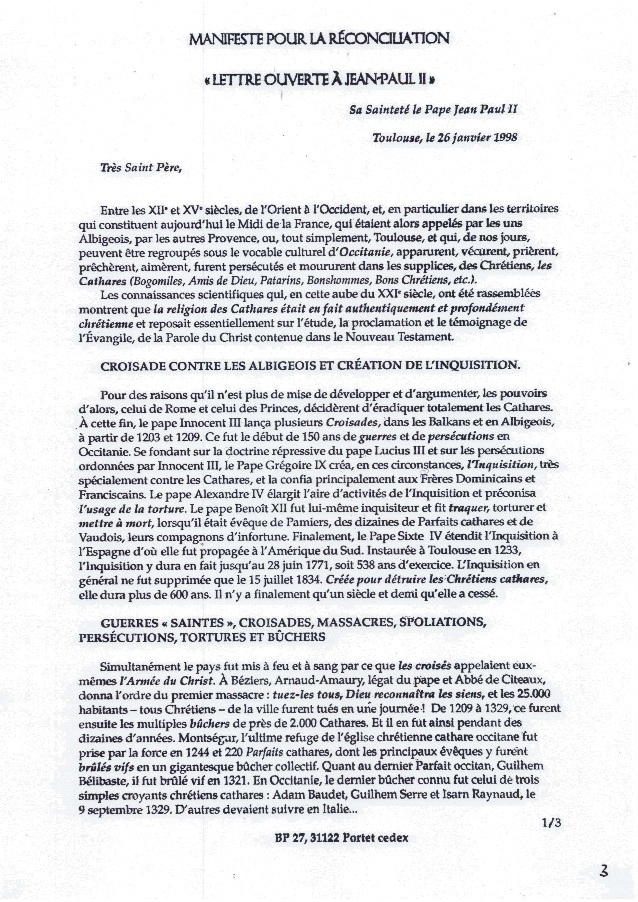
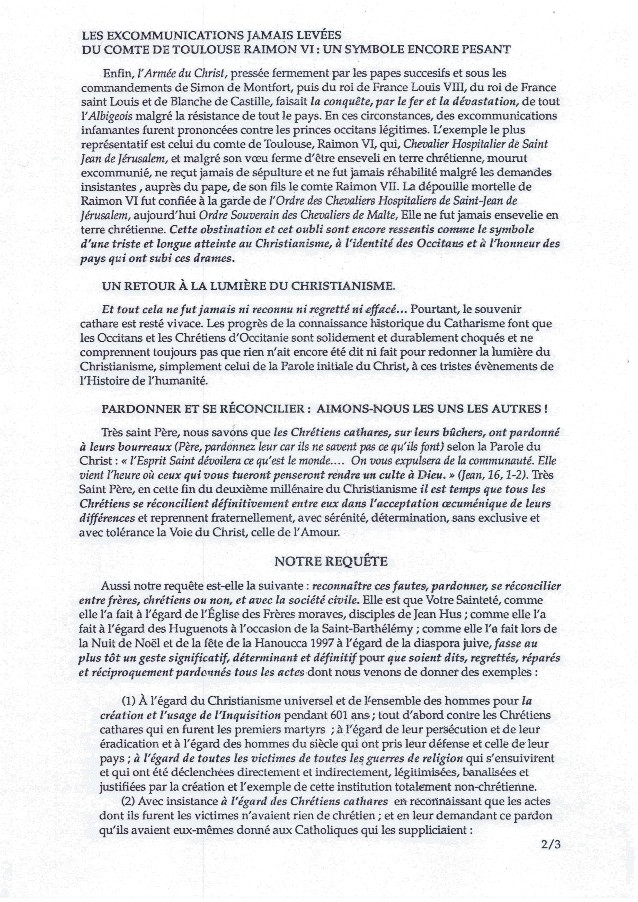
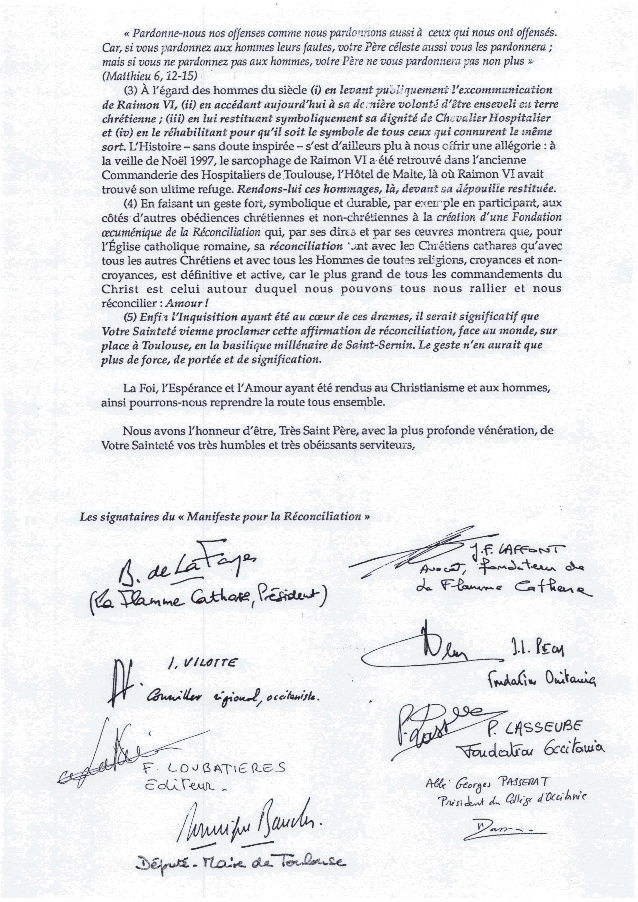
Further Information on Cathars and Cathar Castles
|
If you want to cite this website in a book or academic paper, you will need the following information: Author: James McDonald MA, MSc.
If you want to link to this site please see How to link to www.cathar.info
For media enquiries please e-mail james@cathar.info
|


| CATHAR BELIEFS | CATHAR WARS | CATHOLIC CHURCH | CATHAR INQUISITION | CATHAR CASTLES | CATHAR ORIGINS | CATHAR LEGACY | CATHAR TOURS | CATHAR BOOKS | WHO's
WHO |
CATHAR TIMELINE | MORE INFO |
CATHAR GLOSSARY | CATHAR NEWS |
| |
| |
| |
| |
| |
| :::: Link to www.cathar.info ::: © C&MH 2010-2016 ::: contact@cathar.info ::: Advertising ::: |




